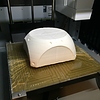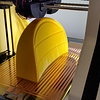You need to work a thin paint scraper or blade under it and lever it off. It’s a PITA when this happens, good luck.
I use a rubber mallet and a paint scraper (scrapper?)
I have had this problem with parts that have a lot of surface area. My printer has no heated bed to heat up and loosen the part, so I used a heat gun (a hair dryer would work also and would probably be much safer) to the bottom of the print bed (glass). Just enough to make the top of the glass almost uncomfortable to touch. Then I use a paint scraper as others have suggested. Be careful and try to keep the heating even on the glass since unevenly heated glass can crack.
When I tried a paint scraper and brute force, I have damaged the bottom edge of the part. Not to mention the force involved could alter the level on your print bed or damage other things.
Agreed, my mallet and paint scraper vs glass and plastic causes a lot of damage. I just replace glass and reprint parts when it happens. A good sized rubber mallet makes up for any parts loss in time savings for me though. Recently I’ve been removing the beds of parts to let them cool and swapping to another build plate so there is little interruption in print time.
Scrapper, but be very careful! I chipped my bed when a print too well.
Most the time you have to let it cool down completely before you try to pull the print off. You should hear popping when the print is cool enough.
If you can, get under one corner of the print (doesnt have to be much), then use floss to slide under that space. Run the floss through the entire print until it comes off. (Better when the bed is cold)
That’s a good idea!
Lol thanks, it works like a charm and your print gets a hint of minty goodness
For ABS you normally hear a pop as the plate cools, so far I have not had any problem removing from a cool plate. I print on glass with glue and I have found if I use too much glue it sticks very hard. My favorite spatula for removing prints is: http://amzn.to/1WpHlwb 34
For PLA you don’t get the nice pop. Instead, I heat the bed to 80 degrees and this loosens the print enough to get the spatula under. Just be careful not to deform the print, the PLA will be soft.
I use a scraper with a single edged razor blade in it.Works best on a cold build plate. Start at a corner. I have wondered if using a can of air for dusting keyboards could be used to cool the bed below room temp to get a release. Never had to try it just a thought.
I use very thin feeler gauges to slide under the print. I then slide progressively larger ones under the same corner until the Gap is big enough to fit my plastic spatula and pray up on it.
I’m proud to be the only one who uses a hammer on prints 
Lol mallet or hammer?
Depends on the print. Really it’s just Newtonian physics. Taking a print off the bed is like pulling a table cloth out from under a fully set table. With the right amount of force you can make that print move away from the bed without the bed absorbing much force. When the force is properly placed between the part and the bed you don’t damage either.
If you have a removable bed pla prints pop themselves off after 2 minutes in the freezer, I use a use a very particular hairspray for bed adhesion with PLA.
As for abs, kapton tape is the way to go, a careful knock with a rubber hammer or if you can ease a chisel infer a corner that works wonders too.
Some good ideas on here I will have to try feeler gauges and dental floss
Just use this, I was skeptic at first but it turns out to be an excellent tool because the edges have a varying thickness:
http://shop.turtlecreations.nl/3DPrinters/3DPrinterAccesoires/buildtak\_spatula
Oooooh.
When I chipped my 2.0 I just bought Buildtak and have not had a problem. Its just a bandaid lol
Oh no! If the build plate is just glass, I cut my own pretty easily from glass at Home Depot / Lowes and a glass cutter (also found at the same place). Just use the cutter to score along the line to cut, put the scored line at the edge of a table and then a quick, even snap will get a clean break.
Another option is to go to a local glass shop. They will cut a pane for you and it won’t cost too much. I couldn’t manage to cut a 18"x18" sheet for my larger printer on my own without cracking it and went to a glass shop.
Either of those options should get you a new glass print bed (assuming you’re on glass) without having to wait for shipping.
This is a great idea ^^ The only issue is you would have to buy the pcb to heat the bed. Probably all together cheaper than XYZ if unless you have a valid warranty. EBay would be another good place to check, I have seen them listed $10-15 cheaper than buying from XYZ.
Also a good idea and the Buildtak might be an upgrade. Of course you could go grab some glass to hold you over and also order some Buildtak.
i use multiple single edge razor blades, make sure the bed and part are cold, or else you will warp the edges/corners, start a razor blade in each corner and gently tap them around the print to loosen it. Usually it will just pop off, if it still doesnt, i take the handle of a screw driver and tap it (with some force) on each side till it pops off. I do this all the time, cause i would rather my completed print be difficult to remove, than it coming loose halfway through a 12 hour print and having a pile of filament laying there.
I used copper tape for stained glass to build my own heater for an oversized print bed on my Robo3D. I figured out how long the copper tape needed to be to match the resistance of the standard heater then spaced the strips so they covered the whole plate. Once installed on the glass they were soldered together and covered with capton tape to prevent damage and shorts. The bed heats quicker than the production bed. Here is a picture of the bed while printing a new customized seatback for my grandsons Big Wheel.
That’s nice, is that the original Robo R1?
That’s awesome – you should post an instructable or something.
It was a kickstarter machine. After breaking my build plate I did a Y axis upgrade and decided to extend the bed. Used a dial indicator and got the Bed flatness to +/- 0.1 mm over whole surface . I played with adding the auto level and found that the head deflected the bed so much that auto level would not work well. So I came up with a new Z switch mount that works great. You can see it on the left. I trapped the Z axis Nuts with an antirotation follower and allow them to float. The switch senses off the floating nut so no more problems with the nuts loosing location if the head hangs up on a blob clinging to the extruder. The Z limit switch always trips. Added a knob to the set screw making it very easy to adjust. Been happy with how it works and I can make some fairly large stuff in one piece.
I can tell you have been doing some playing just by the pictures! That’s amazing!
I have a Borosilicate glass and i work with closed hot bed. When i work with PLA, i use CUBE glue. When the work have finished, i removed the glass from 3d printer and remove the piece with water on the faucet.
Se il piano riscaldato è asportabile e hai usato lacca per capelli per l’adesione del primo layer immergilo in acqua calda e prova ad usare una spatola per colori ad olio per infilarti sotto il primo layer. Puoi provare anche con piano freddo a dare dei colpetti su di uno spigolo ed infilare una spatola tra il vetro e la stampa
devi usare vetro borosilicato spessore 4 mm che resiste bene agli sbalzi termici ed è più robusto
We use ABS juice ( ABS in Acetone) to make sure the print sticks - and then spray with Window cleaner to free the print - works perfectly every time.
I shoot a little canned air upside down on stuck prints and they pop right off.

